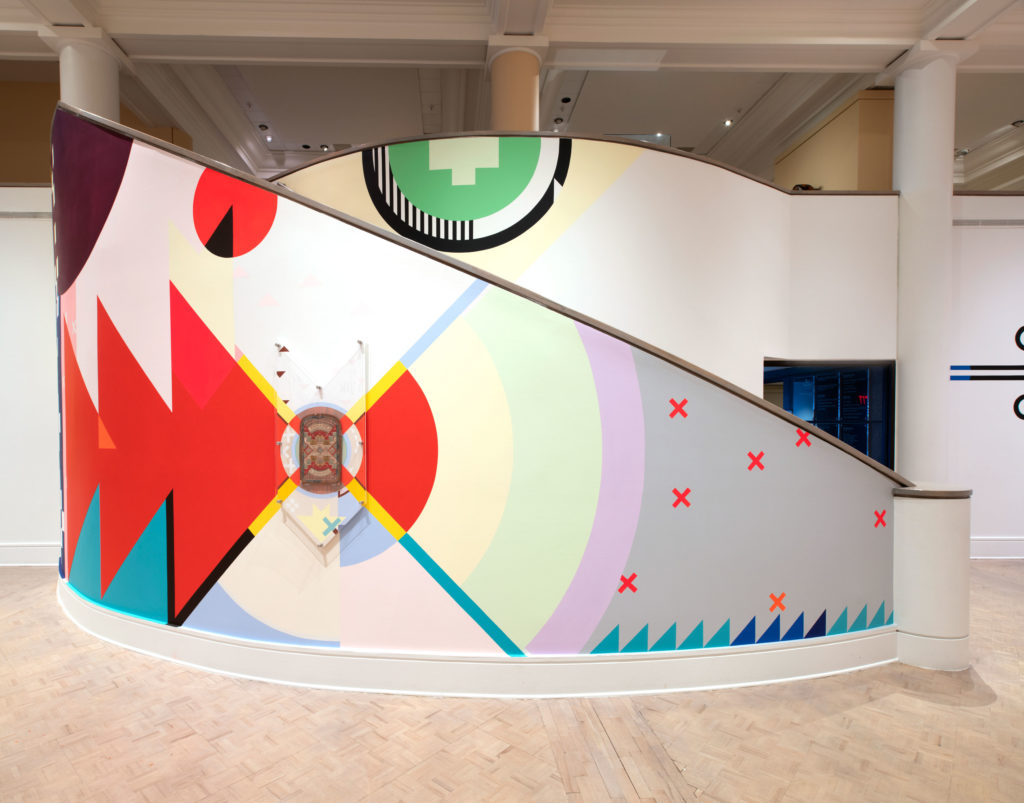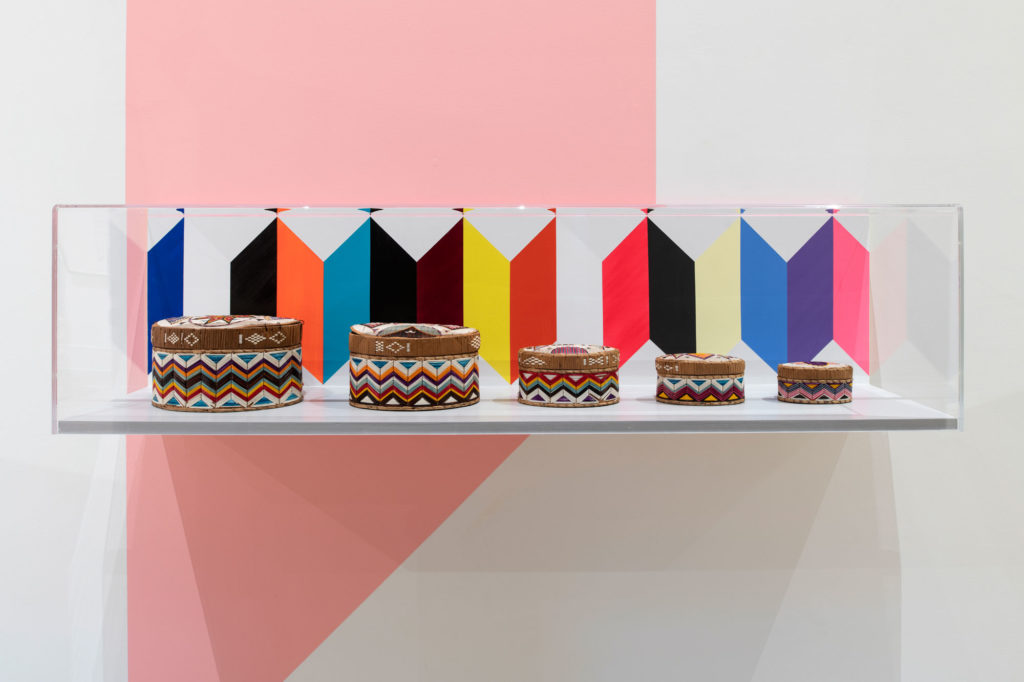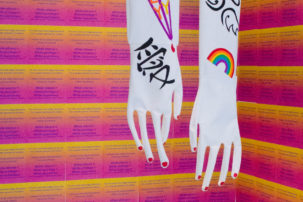In his new exhibition at Art Gallery of Nova Scotia, “Ketu’elmita’jik,” Jordan Bennett has created something truly remarkable. Bennett, who is of Mi’kmaq descent from Stephenville Crossing, Newfoundland and Labrador, is now living in the Halifax region at Terence Bay, Nova Scotia. In this show—whose title term translates as “they want to go home”—Bennett makes full use of the gallery’s architectural quirks to create an immersive environment where traditional Mi’kmaq and Beothuk design motifs take on new life through physical, graphic and conceptual extensions in time and space.
In this show, Bennett refers both to traditional Beothuk and the Mi’kmaq cultural practice. And he also refers to how such practice has been treated—and mistreated—in Western museum contexts. Both the Beothuk and the Mi’kmaq have used bold graphics in their crafts, often objects made from wood, grass, bark and quills—objects designed to be both beautiful and useful. These are objects that wear out, and making them is therefore a process of constant renewal—a process often halted within the Eurocentric context of collecting objects in museums. Bennett, at the AGNS, also alludes to a phenomenon where, post-1492, many Mi’kmaq artisans created objects for European trade. In Victorian England, chair seats and backs were often commissioned in traditional quillwork, as were baskets and other small domestic items.
Such themes manifest in the way that Bennett has gathered several quill seats and backs from museum collections across Canada, and mounted these on the walls of the gallery behind sheets of Plexiglas open on the sides. These objects and their designs, or “stories” as Bennett refers to them, breathe again. The intricate patterns in these older pieces, their colours faded from time and use, are also extended by Bennett—he has painted directly on the gallery’s walls in vibrant colours that approximate hues of the original objects. My eye was dazzled, and I felt I almost heard the colours.
In concert with Bennett’s drawings and paintings, and ensconced within a narrow, high gallery with walls open to an upper mezzanine that holds the AGNS’s First Nations galleries, these extended objects spark a dialogue with many other artworks. (Interestingly, the art also extends beyond the gallery building, in a line of objects such as pins, keychains, scarves and blankets that Bennett has created for sale in the gallery’s gift shop—objects visitors can extend into their own homes and stories.)
Bennett has suggested the analogy of an overflowing basket for this gallery space, and it is apt. For me, the analogy of an echoing valley also works, the combination of stories creating a noise that reaches across space and time.

Installation view of the exhibition “Jordan Bennett: Ketu’elmita’jik” at the Art Gallery of Nova Scotia. Photo: Steve Farmer.

Installation view of the exhibition “Jordan Bennett: Ketu’elmita’jik” at the Art Gallery of Nova Scotia. Photo: Steve Farmer.

Installation view of the exhibition “Jordan Bennett: Ketu’elmita’jik” at the Art Gallery of Nova Scotia. This part of the installation includes a chair back by Catherine Sack (Mrs. Stephen) Maloney of Shubenacadie, Nova Scotia. Her ca. 1892 panel is made of porcupine quill, birchbark, and root, and is from the collection of the Nova Scotia Museum, 1958.37. Photo: Steve Farmer.

Installation view of the exhibition “Jordan Bennett: Ketu’elmita’jik” at the Art Gallery of Nova Scotia.

Installation view of the exhibition “Jordan Bennett: Ketu’elmita’jik” at the Art Gallery of Nova Scotia. Photo: Steve Farmer.

Artist was known, Mi’kmaq, Nova Scotia, chair back panel. Porcupine quill, birchbark, root. Private collection. Displayed in “Jordan Bennett: Ketu’elmita’jik” at the Art Gallery of Nova Scotia. Photo: Steve Farmer.

Artist was known, Mi’kmaq, Nova Scotia, chair seat panel, c. 19th century. Porcupine quill, birchbark, root. Collection of the Canadian Museum of History, III-F-268. Displayed in “Jordan Bennett: Ketu’elmita’jik” at the Art Gallery of Nova Scotia. Photo: Steve Farmer.

Artist was known, Mi’kmaq, Nova Scotia, chair seat panel, ca. 19th century. Porcupine quill, birchbark, root. Collection of the Canadian Museum of History, III-F-268. Displayed in “Jordan Bennett: Ketu’elmita’jik” at the Art Gallery of Nova Scotia. Photo: Steve Farmer.

Installation view of the exhibition “Jordan Bennett: Ketu’elmita’jik” at the Art Gallery of Nova Scotia. Photo: Steve Farmer.

Artist was known, Mi’kmaq Nova Scotia basket. Porcupine quill, birchbark, root. Collection of the Nova Scotia Museum, 1976.68.2. Displayed in “Jordan Bennett: Ketu’elmita’jik” at the Art Gallery of Nova Scotia. Photo: Steve Farmer.

Installation view of the exhibition “Jordan Bennett: Ketu’elmita’jik” at the Art Gallery of Nova Scotia. Photo: Steve Farmer.

Installation view of the exhibition “Jordan Bennett: Ketu’elmita’jik” at the Art Gallery of Nova Scotia. Photo: Steve Farmer.

Installation view of the exhibition “Jordan Bennett: Ketu’elmita’jik” at the Art Gallery of Nova Scotia. Photo: Steve Farmer.

Installation view of the exhibition “Jordan Bennett: Ketu’elmita’jik” at the Art Gallery of Nova Scotia. Photo: Steve Farmer.

 Mrs. Thomas Glode (nee: Bridget Ann Sack), formerly of Shubenacadie, Nova Scotia, nesting baskets. Porcupine quill, birch bark, root. Collection of the Nova Scotia Museum, 1933.49. Displayed in “Jordan Bennett: Ketu’elmita’jik” at the Art Gallery of Nova Scotia. Photo: Steve Farmer.
Mrs. Thomas Glode (nee: Bridget Ann Sack), formerly of Shubenacadie, Nova Scotia, nesting baskets. Porcupine quill, birch bark, root. Collection of the Nova Scotia Museum, 1933.49. Displayed in “Jordan Bennett: Ketu’elmita’jik” at the Art Gallery of Nova Scotia. Photo: Steve Farmer.






